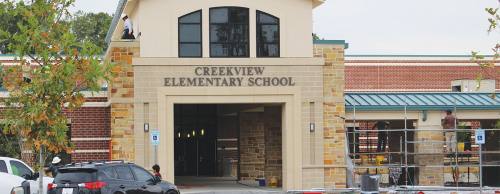Tomball ISD launched new enrollment initiatives this fall, including limited open enrollment and Early College High School programs drawing students from neighboring areas.

Through limited open enrollment, a set number of students residing in school districts other than Tomball can attend select campuses within TISD for the 2017-18 academic year.
Applications for limited open enrollment were made available to students in kindergarten through ninth grade last spring. However, ninth-grade students could only open enroll at Tomball Star Academy—an Early College High School program—for which a more rigorous application was required.
TISD began offering limited open enrollment this fall as a way to increase its revenue, as the district’s funding per student from the state has decreased in recent years, Chief Financial Officer Jim Ross said.
“District funding is based on the average daily attendance of students,” Ross said. “More students yields more revenue for student programs.”
Additionally, TISD Director of Communications Staci Stanfield said by enrolling out-of-district students this fall, TISD could keep more than $600,000 for use within the district instead of sending that money to the state because of recapture—a term coined by Chapter 41 of the Texas Education Code and colloquially known as the “Robin Hood” plan.
Limited open enrollment
TISD Superintendent Martha Salazar-Zamora said the district implemented limited open enrollment as a result of recapture.
“Increasing our student enrollment through limited open enrollment will allow us to keep more of our local tax dollars within Tomball ISD,” she said.
As a district’s enrollment increases, its wealth may decrease because of recapture. According to the Texas Education Agency, TISD is subject to Chapter 41, which requires wealthy districts—as determined by their property value and weighted average daily attendance—to give a portion of their revenue to the state for wealth equalization between districts.
In fiscal year 2017-18, TISD is expected to pay more than $3.7 million of its property tax revenue to the state, according to budget data. This is nearly double the district’s recapture payment in 2016-17.
Additionally, as funding per student has not increased for the district, limited open enrollment provides a way for TISD to receive more funds this year.
According to budget documents, the district’s operating revenue per student has decreased from $7,021 per student in FY 2016-17 to $6,984 per student in FY 2017-18.
Stanfield said about 100 students were granted admission into the district for 2017-18. Based on those students participating in open enrollment with TISD, the district could retain an additional $626,300 of its property tax revenue this fall.
Although parents of students enrolling in TISD via the limited open enrollment initiative neither pay tuition nor property taxes to TISD, the district sends $6,263 less to the state per enrolled student, Stanfield said.
“The program is a win-win situation because students who enroll through limited open enrollment are able to benefit from Tomball ISD’s excellent facilities, exemplary instructional program and dedicated teaching and support staff,” she said.
In Tomball, accepted students attend one of nine campuses, depending on grade level, available space and staff capacity. Students must provide their own transportation to and from school. Enrolling out-of-district students also did not require additional staff at these facilities, district officials said.
“Limited open enrollment applications must be renewed every year,” Stanfield said. “However, it is the goal of Tomball ISD that all limited open enrollment students in good standing will remain in the district through high school and receive a Tomball ISD diploma.”

Tomball Star Academy
At the high school level, TISD unveiled its Early College High School program this fall in partnership with Lone Star College-Tomball, Stanfield said. Its inaugural class of 105 ninth-grade students began classes Aug. 22.
“My hope is that our students become the leaders of our future,” Tomball Star Academy Principal Kim McKinney said. “I’d like to see them learn good digital citizenship, become servant leaders within our community and become lifelong learners.”
Upon admission to the program, students begin at Tomball Star Academy as high school freshmen. Admission is based upon academic performance, attendance, behavior, State of Texas Assessments of Academic Readiness results, an interview and an essay, according to district information. At the time of graduation, students may receive an Associate of Arts degree from LSC-Tomball in addition to a high school diploma.
“LSC-Tomball and Tomball ISD have been partners in education for a very long time,” said Lee Ann Nutt, president of LSC-Tomball. “Forming an early college high school was an easy next step because of the foundational relationship that had already been formed. The need was there, and the timing was right for both of us.”
According to the TEA, districts across the state are offering 198 Early College High School programs in 2017-18.
“Tomball Star Academy will operate as a completely separate campus,” McKinney said. “Tomball Star Academy enables students to save time and money while earning a high school diploma and an Associate of Arts degree completely free of charge. We also offer a smaller learning environment that appeals to our students.”
According to the 2017-18 rate per credit hour at LSC-Tomball for in-district residents, Tomball Star Academy can save students $4,000 or more by offering 60 credit hours at no cost.
Although Tomball Star Academy shares an address with Tomball High School, located at 30330 Quinn Road, Tomball, students at Tomball Star Academy have their own set of facilities, including a separate cafeteria, on the second floor of the school. The auditorium and gymnasium are shared between schools, McKinney said. Stanfield said no facility renovations were needed for the program’s start.

While Tomball Star Academy students will not participate in University Interscholastic League events, students may choose to participate in extracurricular activities, such as robotics, drama, intramural sports and music, Stanfield said.
“Tomball Star Academy is a unique school for students focused on academics. We’re thrilled to offer students a setting that makes higher education more accessible while still in high school,” Salazar-Zamora said. “We’re also thrilled to partner with Lone Star College-Tomball on this joint venture, and we look forward to supporting our students as they pursue their goals.”
 Through limited open enrollment, a set number of students residing in school districts other than Tomball can attend select campuses within TISD for the 2017-18 academic year.
Applications for limited open enrollment were made available to students in kindergarten through ninth grade last spring. However, ninth-grade students could only open enroll at Tomball Star Academy—an Early College High School program—for which a more rigorous application was required.
TISD began offering limited open enrollment this fall as a way to increase its revenue, as the district’s funding per student from the state has decreased in recent years, Chief Financial Officer Jim Ross said.
“District funding is based on the average daily attendance of students,” Ross said. “More students yields more revenue for student programs.”
Additionally, TISD Director of Communications Staci Stanfield said by enrolling out-of-district students this fall, TISD could keep more than $600,000 for use within the district instead of sending that money to the state because of recapture—a term coined by Chapter 41 of the Texas Education Code and colloquially known as the “Robin Hood” plan.
Through limited open enrollment, a set number of students residing in school districts other than Tomball can attend select campuses within TISD for the 2017-18 academic year.
Applications for limited open enrollment were made available to students in kindergarten through ninth grade last spring. However, ninth-grade students could only open enroll at Tomball Star Academy—an Early College High School program—for which a more rigorous application was required.
TISD began offering limited open enrollment this fall as a way to increase its revenue, as the district’s funding per student from the state has decreased in recent years, Chief Financial Officer Jim Ross said.
“District funding is based on the average daily attendance of students,” Ross said. “More students yields more revenue for student programs.”
Additionally, TISD Director of Communications Staci Stanfield said by enrolling out-of-district students this fall, TISD could keep more than $600,000 for use within the district instead of sending that money to the state because of recapture—a term coined by Chapter 41 of the Texas Education Code and colloquially known as the “Robin Hood” plan.

 While Tomball Star Academy students will not participate in University Interscholastic League events, students may choose to participate in extracurricular activities, such as robotics, drama, intramural sports and music, Stanfield said.
“Tomball Star Academy is a unique school for students focused on academics. We’re thrilled to offer students a setting that makes higher education more accessible while still in high school,” Salazar-Zamora said. “We’re also thrilled to partner with Lone Star College-Tomball on this joint venture, and we look forward to supporting our students as they pursue their goals.”
While Tomball Star Academy students will not participate in University Interscholastic League events, students may choose to participate in extracurricular activities, such as robotics, drama, intramural sports and music, Stanfield said.
“Tomball Star Academy is a unique school for students focused on academics. We’re thrilled to offer students a setting that makes higher education more accessible while still in high school,” Salazar-Zamora said. “We’re also thrilled to partner with Lone Star College-Tomball on this joint venture, and we look forward to supporting our students as they pursue their goals.”





